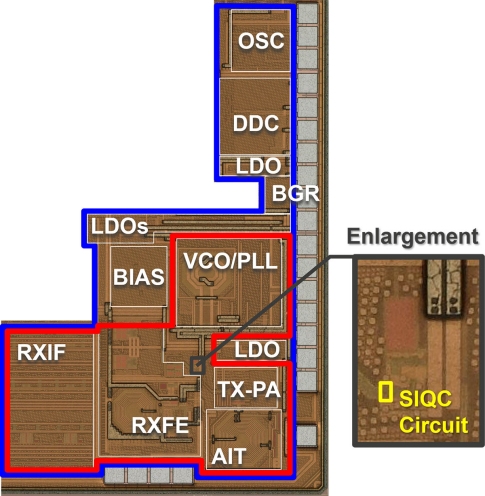瑞萨电子打造可简化电路板设计、缩小电路面积并提高功效的低功耗蓝牙射频收发器技术
Announced at ISSCC 2022: Impedance Tuning and Reference Signal Self-Correction Technologies Can Facilitate Bluetooth LE Implementation in IoT Devices
TOKYO, Japan ― February 24, 2022 -- Renesas Electronics Corporation (TSE:6723), a premier supplier of advanced semiconductor solutions, today announced the development of two 2.4 GHz RF transceiver technologies that support the Bluetooth® Low Energy (LE) low-power, near-field communication standard. The new technologies also achieve a smaller mounting area and better power efficiency. Renesas presented these technologies at International Solid-State Circuits Conference 2022 (ISSCC 2022), held between February 20 and 24 in San Francisco.
In addition to being compact, low cost, and power efficient, IoT devices must provide flexible support for Bluetooth LE regardless of their implementation format. Renesas has developed two new technologies to address these requirements: 1) a matching circuit technology that covers a wide impedance range and enables the IC to match a variety of antenna and board impedances without an external impedance-matching circuit; 2) a signal correction technology for locally generated reference signals that uses a small circuit to self correct inconsistencies in the circuit elements and variations in surrounding conditions without calibration.
Renesas has verified the effectiveness of these technologies on a Bluetooth LE RF transceiver circuit prototype built with a 22-nm CMOS process. With these new technologies, Renesas reduced the circuit area including the power supply to 0.84 mm2, the world’s smallest for a device of this type. This was achieved by modifying the receiver architecture to reduce the number of inductors and making enhancements such as a low-current baseband amplifier with a small mounting area and a highly efficient class-D amplifier. They offer best-in-class power efficiency, with power consumption of 3.6 mW and 4.1 mW during reception and transmission respectively. These advances enable smaller size, reduced board cost, and lower power consumption, while simplifying the board design process.

Bluetooth LE RF Transceiver Circuit Prototype Chip
The benefits of the new RF transceiver technologies are:
1. Matching Circuit Technology Covering Wide Impedance Range (On-chip Antenna Impedance Tuner, AIT)
The integrated impedance-matching circuit technology presented by Renesas at ISSCC 2015 enabled compact and low-cost Bluetooth LE products that required no external inductors or capacitors for switching between reception and transmission or impedance matching. However, depending on the type of antenna or board design considerations, the impedance did not necessarily reach 50 Ω and an external matching circuit was still needed. In addition, when using the earlier technology and adding a matching circuit with impedance-changing functionality, issues involving increased signal loss and inability to achieve a sufficient range of variation could still arise.
To address these issues, Renesas has developed a new variable impedance-matching circuit technology that consists of two inductors and four variable capacitors. The transmitter-side inductor and receiver-side inductor used in the matching circuit are configured in a concentric arrangement, and their mutual induction is employed to reduce signal loss and cut the effective parasitic capacitance. This both expands the variable impedance range and substantially shrinks the circuit area. A voltage standing wave ratio (VSWR), which indicates impedance mismatches, equivalent to maximum 6.8 and a variable impedance range of approximately 25 to 300 Ω have been confirmed.
2. Reference Signal Self-Correction Circuit Technology Eliminating Need for Calibration Circuit (Self-IQ-Phase Correction, SIQC)
A reference signal (locally generated signal) of roughly the same frequency as that of the wireless radio signals received via the antenna is generated internally by the RF transceiver. The signal is used to convert gigahertz-band wireless signals to low-frequency baseband signals. The accuracy of the reference signal can be degraded by factors such as inconsistencies in the circuit elements or variations in the temperature or supply voltage. In the past, the compensation technology for phase and amplitude deviations with a calibration circuit was used to accurately generate the reference signal. This led to problems, however, because integrating such a calibration circuit required a larger chip area, higher power consumption, and increased test cost.
Renesas resolved these issues by developing a new self-IQ-phase correction circuit technology that uses reference signals of four different phases to correct each other by allowing the phase differences to cancel each other out. This self-correction circuit is much smaller and can be implemented at approximately one-twelfth the size of a conventional calibration circuit. The image signal rejection ratio, crucial to reception performance, averages 39 dB, which meets the Bluetooth standard with a comfortable margin to spare.
These technologies are applicable to different types of RF transceivers in addition to Bluetooth LE, and Renesas is currently working on practical applications for these technologies.
About Renesas Electronics Corporation
Renesas Electronics Corporation (TSE: 6723) delivers trusted embedded design innovation with complete semiconductor solutions that enable billions of connected, intelligent devices to enhance the way people work and live. A global leader in microcontrollers, analog, power, and SoC products, Renesas provides comprehensive solutions for a broad range of automotive, industrial, infrastructure, and IoT applications that help shape a limitless future. Learn more at renesas.com.
Related Semiconductor IP
- Bluetooth Low Energy
- Bluetooth Low Energy Subsystem IP
- Bluetooth Low Energy Subsystem IP – v6.0
- Bluetooth Low Energy 6.0 Scalable RF IP
- Bluetooth Low Energy IP
Related News
- Synopsys发布物联网SOC应用的DesignWare Bluetooth完整低功耗IP解决方案 (包含TSMC 40ULP的PHY和Link Layer)
- AndesCore超低功耗,高性能N705 CPU内核获准用于Sino Wealth电子公司全新蓝牙低功耗芯片设计
- CEVA的Bluetooth 5低功耗IP为安森美半导体的超低功耗无线SoC提供物联网和连接健康设备
- 上海频微电子有限公司许可并部署CEVA蓝牙低功耗IP新IoT产品线